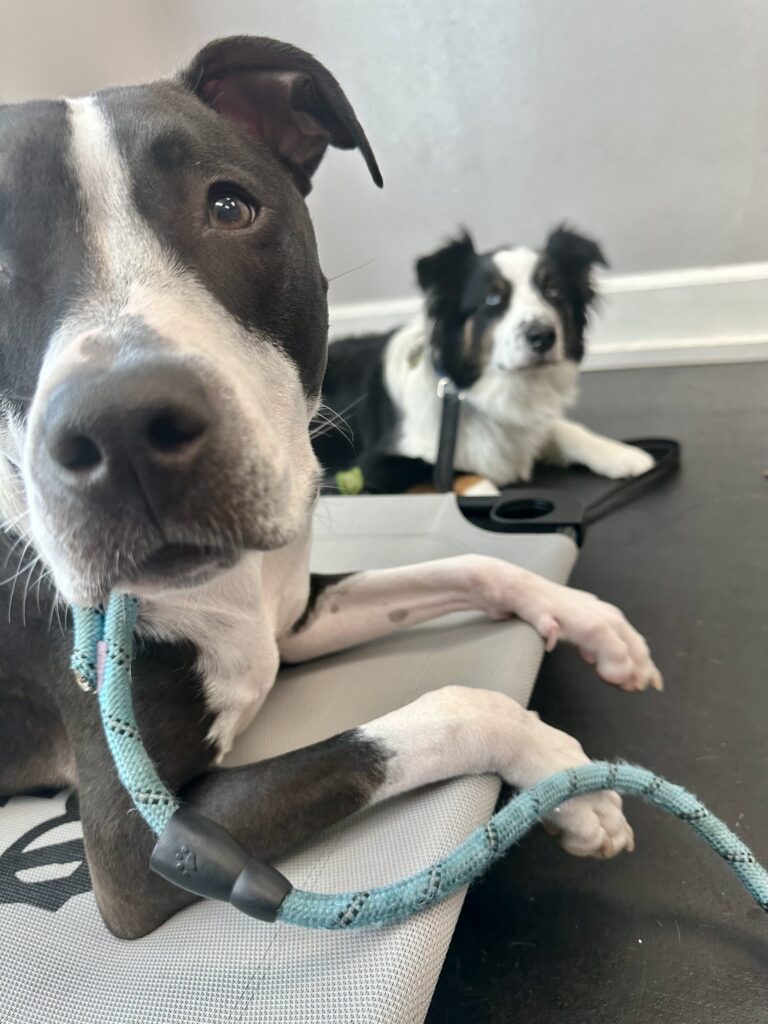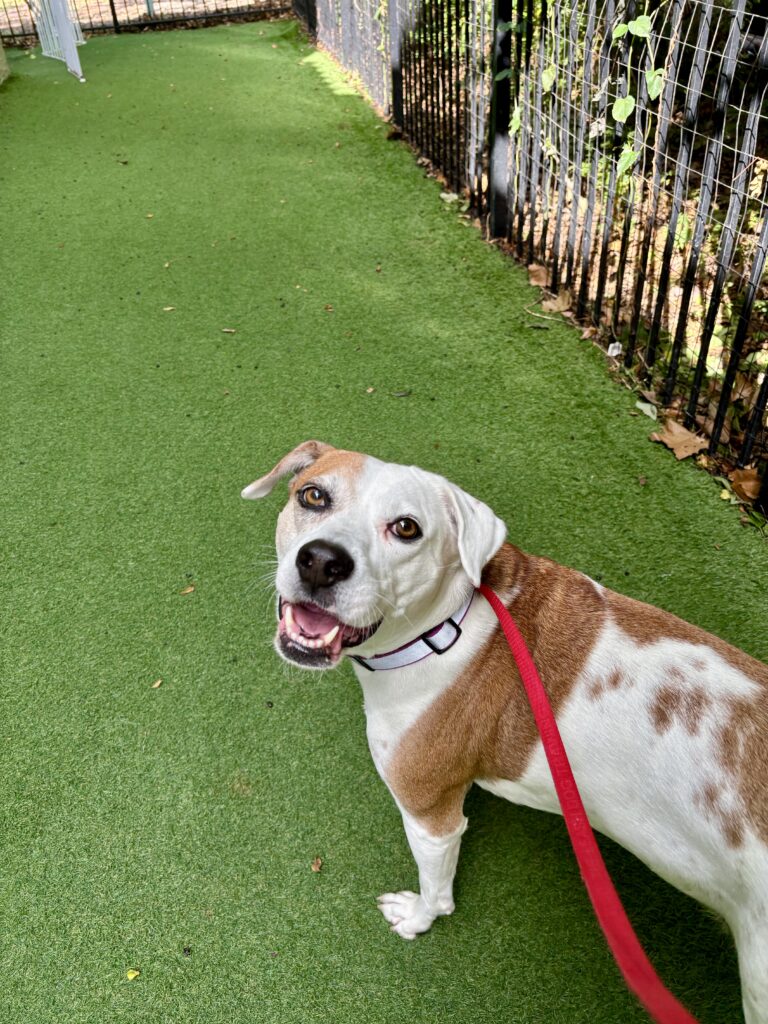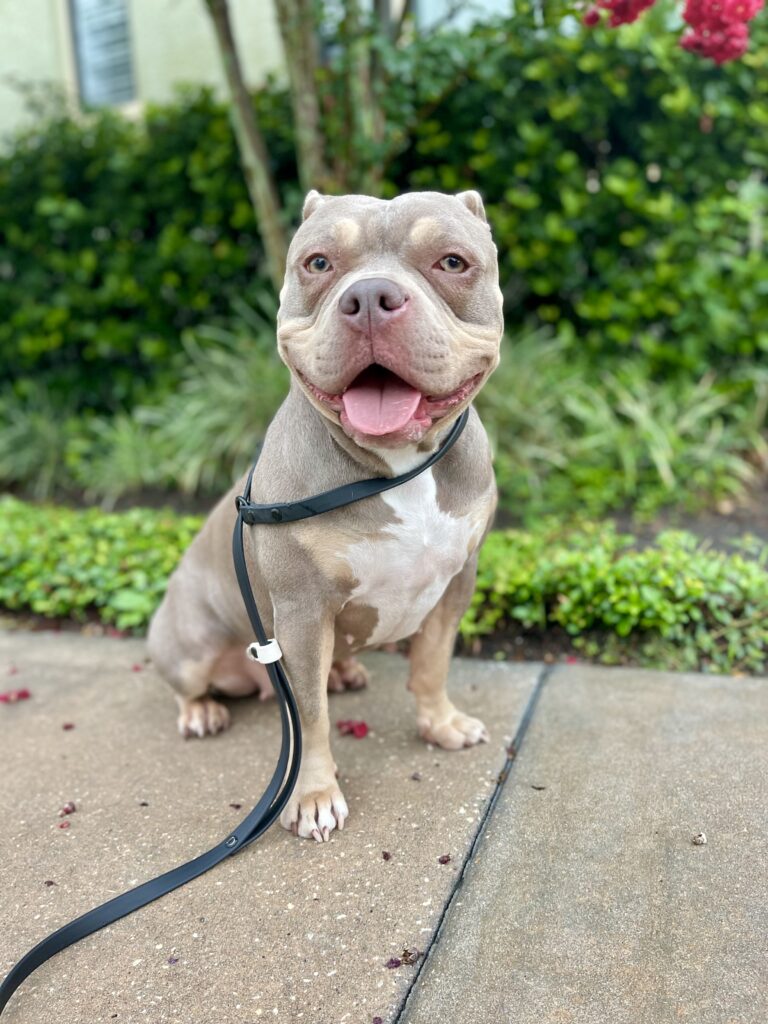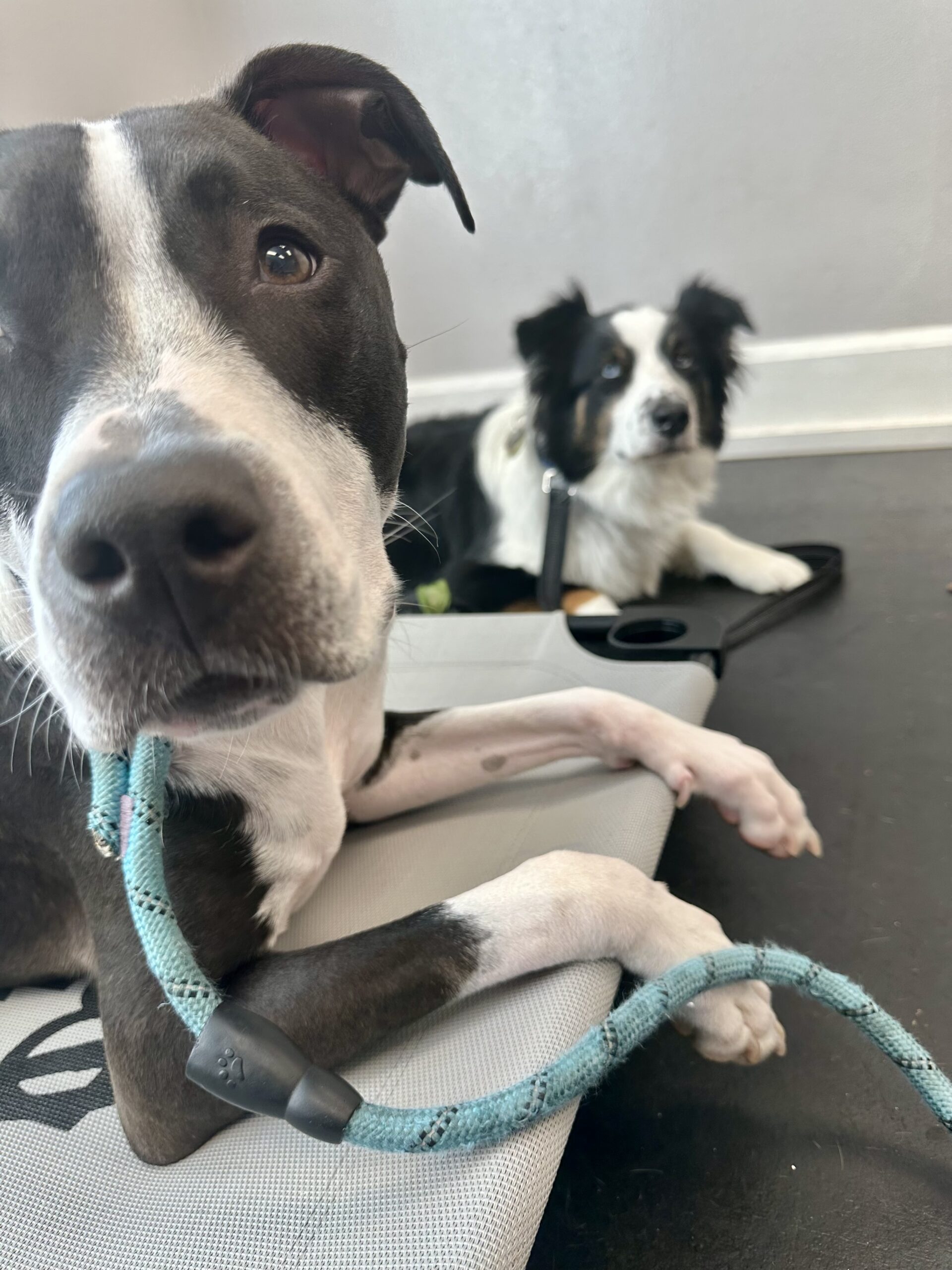If you’ve ever had your dog go full meltdown mode at the sight of another dog, a stranger, or even a deer in the yard, you’re not alone. Many dogs bark when they see something unusual—it’s normal. But when that barking turns into growling, lunging, and an inability to calm down, you might be dealing with reactivity.
Reactivity in dogs isn’t about “bad behavior” or a desire to be aggressive. It’s usually an emotional overreaction, rooted in fear, excitement, or frustration.
What Does Reactivity Look Like?
Reactive dogs often respond to stimuli with behaviors that seem dramatic or over the top. You might see:
- Barking
- Growling
- Lunging
- Spinning
- Whining
- Restlessness
- Hunched posture
- Inability to focus
- Intense vigilance or hyper-awareness

These responses can be misinterpreted as aggression, especially since the body language can look similar. But more often than not, reactive dogs are overwhelmed or distressed, not aggressive.
Why Are Some Dogs Reactive?
Reactivity can be caused by several factors:
- Genetics: Some breeds (like herding or guarding dogs) have traits that, when unmanaged, can lead to reactive behavior.
- Lack of socialization: Dogs that didn’t have positive early exposure to different people, animals, and environments may become reactive later in life.
- Negative experiences: A scary encounter with another dog or person can leave lasting effects.
- Frustration or excitement: Sometimes a dog just really wants to interact and gets worked up when they can’t.
- The environment: Crowded spaces, noisy areas, or being leashed near another dog can all contribute to reactive outbursts.
Is Reactivity the Same as Aggression?
Not quite. A barking, lunging dog might look aggressive, but most reactivity is rooted in emotion, not intent to harm. Aggression is typically purposeful and meant to create distance or protect. Reactivity, on the other hand, is an explosion of emotion—a dog that’s just overwhelmed and doesn’t know how to cope.
🔧 Management: Setting Up for Success

Management means altering the environment to prevent your dog from reacting in the first place. It’s not a long-term solution, but it reduces stress and makes day-to-day life more manageable.
Examples of management:
- During gatherings, place your dog in their crate with some white noise, and a stuffed kong.
- Walk your dog at quieter times or in low-traffic areas to avoid triggers.
Think of management like baby-proofing your house—it’s not changing your child’s behavior, but it’s keeping them safe while they learn.
🎓 Training: Helping Your Dog Learn New Responses
Training takes time but creates lasting change. The goal is to help your dog feel more comfortable and confident around triggers.
Key tips for training reactive dogs:
- Use positive reinforcement (treats, praise) to reward calm behavior.
- Keep distance from triggers—find your dog’s “safe zone” and slowly work closer over time.
- Practice engagement games to help your dog focus on you during walks.
- Pair triggers with good things—see a dog, get a treat—so your pup builds a new association.
Can Reactive Dogs Be Socialized?
That depends on how you define “socialized.” If you’re imagining a dog park full of tail-wagging playdates, that may not be realistic for every reactive dog. And that’s okay.
Realistic socialization goals:
- Calmly walking past people or dogs without reacting
- Tolerating guests in the home
- Ignoring other dogs from a distance
Your dog might never be a social butterfly, but they can absolutely learn to exist peacefully in the world.

Tips for Living With a Reactive Dog
✔️ Be your dog’s advocate
Don’t force interactions or push your dog into uncomfortable situations. They’re counting on you to keep them safe.
✔️ Mind your energy
Dogs are incredibly tuned into our emotions. If you’re tense, your dog will feel it. Breathe, relax your body, and keep the leash loose.
✔️ Never punish reactivity
Punishment can increase fear and frustration, worsening reactivity. Instead, focus on positive reinforcement and understanding.
✔️ Check for health issues
If your dog suddenly becomes reactive or their behavior worsens, schedule a vet visit to rule out pain or illness.
✔️ Exercise matters
A bored, under-stimulated dog is more likely to become reactive. Try puzzle toys, scent games, and walks in quiet areas to keep your dog’s brain and body busy.

Living with a reactive dog can feel overwhelming, especially when it seems like everyone else’s dog is easygoing and social. But progress is possible—sometimes in leaps, sometimes in baby steps.
With empathy, patience, and the right tools, your dog can learn to feel safe, and you can enjoy a calmer, more connected relationship.
You’re not alone. And your dog isn’t broken—they just need a little extra help navigating a big, loud world.
Want help creating a training plan for your reactive dog? Let us know in the comments or reach out—we’d love to support you on your journey! 🐾
If you’ve ever had your dog go full meltdown mode at the sight of another dog, a stranger, or even a deer in the yard, you’re not alone. Many dogs bark when they see something unusual—it’s normal. But when that barking turns into growling, lunging, and an inability to calm down, you might be dealing with reactivity.
Reactivity in dogs isn’t about “bad behavior” or a desire to be aggressive. It’s usually an emotional overreaction, rooted in fear, excitement, or frustration.
What Does Reactivity Look Like?
Reactive dogs often respond to stimuli with behaviors that seem dramatic or over the top. You might see:
- Barking
- Growling
- Lunging
- Spinning
- Whining
- Restlessness
- Hunched posture
- Inability to focus
- Intense vigilance or hyper-awareness

These responses can be misinterpreted as aggression, especially since the body language can look similar. But more often than not, reactive dogs are overwhelmed or distressed, not aggressive.
Why Are Some Dogs Reactive?
Reactivity can be caused by several factors:
- Genetics: Some breeds (like herding or guarding dogs) have traits that, when unmanaged, can lead to reactive behavior.
- Lack of socialization: Dogs that didn’t have positive early exposure to different people, animals, and environments may become reactive later in life.
- Negative experiences: A scary encounter with another dog or person can leave lasting effects.
- Frustration or excitement: Sometimes a dog just really wants to interact and gets worked up when they can’t.
- The environment: Crowded spaces, noisy areas, or being leashed near another dog can all contribute to reactive outbursts.
Is Reactivity the Same as Aggression?
Not quite. A barking, lunging dog might look aggressive, but most reactivity is rooted in emotion, not intent to harm. Aggression is typically purposeful and meant to create distance or protect. Reactivity, on the other hand, is an explosion of emotion—a dog that’s just overwhelmed and doesn’t know how to cope.
🔧 Management: Setting Up for Success

Management means altering the environment to prevent your dog from reacting in the first place. It’s not a long-term solution, but it reduces stress and makes day-to-day life more manageable.
Examples of management:
- During gatherings, place your dog in their crate with some white noise, and a stuffed kong.
- Walk your dog at quieter times or in low-traffic areas to avoid triggers.
Think of management like baby-proofing your house—it’s not changing your child’s behavior, but it’s keeping them safe while they learn.
🎓 Training: Helping Your Dog Learn New Responses
Training takes time but creates lasting change. The goal is to help your dog feel more comfortable and confident around triggers.
Key tips for training reactive dogs:
- Use positive reinforcement (treats, praise) to reward calm behavior.
- Keep distance from triggers—find your dog’s “safe zone” and slowly work closer over time.
- Practice engagement games to help your dog focus on you during walks.
- Pair triggers with good things—see a dog, get a treat—so your pup builds a new association.
Can Reactive Dogs Be Socialized?
That depends on how you define “socialized.” If you’re imagining a dog park full of tail-wagging playdates, that may not be realistic for every reactive dog. And that’s okay.
Realistic socialization goals:
- Calmly walking past people or dogs without reacting
- Tolerating guests in the home
- Ignoring other dogs from a distance
Your dog might never be a social butterfly, but they can absolutely learn to exist peacefully in the world.

Tips for Living With a Reactive Dog
✔️ Be your dog’s advocate
Don’t force interactions or push your dog into uncomfortable situations. They’re counting on you to keep them safe.
✔️ Mind your energy
Dogs are incredibly tuned into our emotions. If you’re tense, your dog will feel it. Breathe, relax your body, and keep the leash loose.
✔️ Never punish reactivity
Punishment can increase fear and frustration, worsening reactivity. Instead, focus on positive reinforcement and understanding.
✔️ Check for health issues
If your dog suddenly becomes reactive or their behavior worsens, schedule a vet visit to rule out pain or illness.
✔️ Exercise matters
A bored, under-stimulated dog is more likely to become reactive. Try puzzle toys, scent games, and walks in quiet areas to keep your dog’s brain and body busy.

Living with a reactive dog can feel overwhelming, especially when it seems like everyone else’s dog is easygoing and social. But progress is possible—sometimes in leaps, sometimes in baby steps.
With empathy, patience, and the right tools, your dog can learn to feel safe, and you can enjoy a calmer, more connected relationship.
You’re not alone. And your dog isn’t broken—they just need a little extra help navigating a big, loud world.
Want help creating a training plan for your reactive dog? Let us know in the comments or reach out—we’d love to support you on your journey! 🐾

Comments